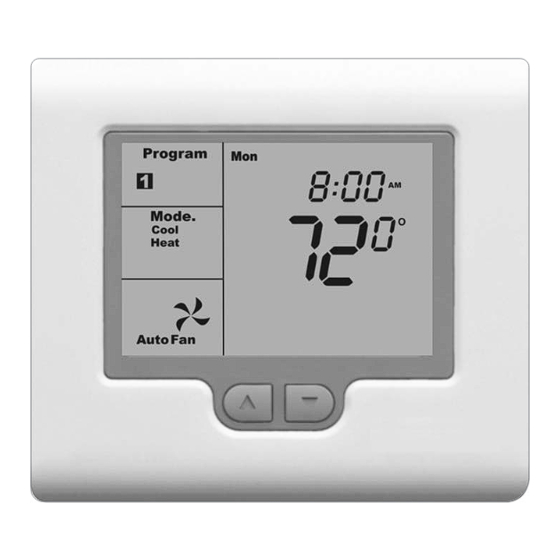
Jackson Systems Comfort System T-32-P Operation Manual
Hide thumbs
Also See for Comfort System T-32-P:
- Installation manual (19 pages) ,
- Installation manual (11 pages)
Table of Contents
Advertisement
Quick Links
Download this manual
See also:
Installation Manual
Advertisement
Table of Contents

Summary of Contents for Jackson Systems Comfort System T-32-P
- Page 1 Comfort System T-32-P Universal Thermostat Operation Manual...
- Page 2 Great care has been taken in the preparation of this manual. Jackson Systems takes no responsibility for errors or omissions contained in this document. It is the responsiblity of the user to ensure that this thermostat, or equipment connected to it is operating to their respective specifications and in a safe manner.
-
Page 3: Residential Programmable Mode
Residential Programmable Mode MODE Selection Press the MODE key to cycle through the modes of operation and the LCD will display the following: Heat Heat Mode Cool Heat Cool Cool Mode Auto Changeover (Installer must Cool activate this mode) Heat E. - Page 4 Programming 4 daily events The T-32-P can be programmed to provide 4 individual time-of-day temperature settings for each day of the week. Each event is noted on the LCD by numerals At the start of each event, the programmed heating and cooling temperature will be maintained until the next event starts.
- Page 5 Press the PROG key again and the same day selected will be shown along with the number 1 1 2 which represents the second program event. The hour will flash indicating that this value can now be programmed. Use the up ( ) or down ( ) key to advance the hour to the second event start time. Make sure that the AM / PM is correct.
-
Page 6: Commercial Programmable Mode
The LCD will now flash the current program number to remind you that an override is in progress. The override temperature settings will remain in effect until the override time expires or until the next scheduled event (whichever comes first). You can return to the programmed schedule at any time by pressing the O/RIDE key and then pressing it again. - Page 7 FAN Selection Press the key to cycle through the fan selections. More details on fan functions can be found on page 20 of this manual. Auto The HVAC system fan will only run with a call for heating or cooling. The HVAC system fan will run continuously.
- Page 8 Press the PROG key again and the LCD will display the word and the temperature setting for the current mode ( Heat Cool ). Press the ( ) or down ( ) key to change the setpoint. If Auto mode is selected (shown by both Heat Cool...
-
Page 9: Non-Programmable Mode
Reviewing Set Temperatures Your can review the set temperatures at any time by simply pressing the up ( ) or down ( ) key. Advanced Fan Operation In many commercial applications, code requires constant ventilation during occupied periods. The HVAC installer can configure the T-32-P to allow the fan to run continuously during the START schedule. -
Page 10: Common Functions
Setting the clock The T-32-P has a real-time clock. To set the clock, press the PROG key until the hour flashes on the LCD. Use the up ( ) or down ( ) key to Cool set the current hour along with the AM and PM Heat symbol. - Page 11 O/RIDE Key (Override) Residential Programmable Mode O/RIDE key is used to override the programmed schedule and to hold the current set temperature indefinitely or until the O/RIDE button is pressed again. The word will be displayed on the LCD to confirm this function is active. HOLD O/RIDE Key (Override)
- Page 12 Cooling Call When the T-32-P is in the Cool mode and there is a call for cooling, the LCD will display the word Cooling . If the word Cool flashes, this confirms that the T-32-P is initiating a time delay before the cooling call takes place.
-
Page 13: Troubleshooting
Troubleshooting LCD display is blank • Check HVAC circuit breaker and reset if necessary. • Make sure power switch at HVAC system is on. • Make sure furnace door is closed securely. Heating or cooling • Press MODE key to set system to Heat. Make sure the system does not temperature is set higher than the inside temperature.










Need help?
Do you have a question about the Comfort System T-32-P and is the answer not in the manual?
Questions and answers